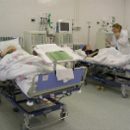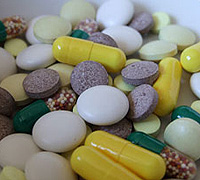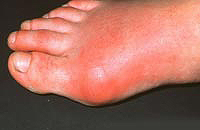What is pyelonephritis? What are the symptoms of pyelonephritis? What forms of pyelonephritis are? How to diagnose and treatment of pyelonephritis? What are the complications of pyelonephritis? What is the disease forecast? Answers to these questions you will find in the article.
Content
Pyelonephritis
Pyelonephritis is a non-specific infectious inflammatory
The process in which a cup-making system and kidney parenchyma is involved primarily
Its interstitial fabric.
Pyelonephritis is the most frequent kidney disease. Women young
and middle age suffer pyelonephritis 5 times more often than men.
Pyelonephritis divide on sharp and chronic, primary and secondary.
Secondary (obstructive) pyelonephritis develops against the background of impaired urine outflow from
Urinary Ways due to their obstruction or commemoration. Primary
(unstructive) pyelonephritis develops in the absence of obstruction of the upper urinary
paths.
More often meets secondary (obstructive) pyelonephritis (up to 84%).
Pyelonephritis can be caused by any endogenous or exogenous
microorganisms that penetrate the kidney. In 90% of cases, the cause of the disease is
Gram-negative microorganisms, of which 50% - intestinal wand
Infectious agents can get into the kidney in three ways:
- hematogenic, in the presence of primary foci of inflammation in organs
GOOD SYSTEM (SalpingoForit, cystitis, prostatitis and etc.) or other organs
(tonsillitis, sinusitis, carious teeth, bronchitis, furunculosis and etc.);
- ascending urinic (on the lumen of the ureter);
-
ascending by subepithelny wall spaces
Ureteral.
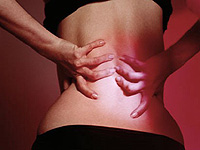 The development of ascending urinic pyelonephritis is possible only
The development of ascending urinic pyelonephritis is possible only
The presence of an infected urine in the bladder, which will fall into a cup and looscopic
System by bubble uretera reflux. Then microorganisms penetrate into
Parenchima kidney from a cup-making system in the occurrence of shabby renal
Reflux. The latter there are two main species: Fullnought (when damaged the arch
Cups) and tubular (by the lumen of the kidney channels). With ascending urinogenic
Infectness Perhaps the accession and hematogenic way to hit the kidney infection,
When, due to the pyelovenial or pyelolymphatic reflux, the microbes penetrate
Common blood flow through the venous system, and then, returning to the arterial system in the same
kidney cause an inflammatory process.
A number of microbial agents (intestinal wand, protea and others.) Posses
Ability to adhere to the epithelial cells of urinary tract with specific
Fambry.
Among local changes in kidneys and upper urinary tract
The development of pyelonephritis, the leading role belongs to the violation of the passage of urine (obstruction
Stone, stricture of the ureter and others.). Urinary bubble broken outflow also
May be caused by the development of pyelonephritis (adenoma and prostate cancer,
Stricks and Urethra Valves, phimoz). Arising in the parenchym kidney
Hemodynamic changes make an interstitial fabric very attractive for
Life activity microorganisms.
Significant importance in the occurrence of pyelonephritis has a general
Condition of the organism. Nutrition of nutrition, supercooling, overwork, hypovitaminosis,
Dehydration, colds, liver disease, endocrine, cardiovascular
systems reduce body resistance and make it susceptible to infection.
Symptoms and shapes of pyelonephritis
The clinical picture of acute pyelonephritis is determined by the stage
diseases, the presence or absence of complications and a combination of general signs of severe
infectious process and local symptoms.
Pyelonephritis stages correspond to morphological changes in
kidney.
Starting stage of the disease - serous pyelonephritis, duration
which varies from 6 to 36 hours. Subsequent stages of the disease are characterized by purulent,
destructive changes that develop in the following sequence:
Apostleatous pyelonephritis, kidney carbuncoon, kidney abscess, purulent Paranefrit.
Apostatient pyelonephritis Characterized by the appearance
small (1-2 mm) multiple guns in the cortical substance kidney and on it
Surface.
Carbuncoon kidney develops in cortical matter
Due to the merger of guns, with apostleatous pyelonephritis or as a result of hitting
microbial embol in the end arterial kidney vessel, which is manifested by a combination
ischemic, necrotic and purulent-inflammatory processes.
Abscess kidneys It is the result of purulent
Melting parenchyma in the focus of the fusion of the Apostle or Carbuncle of the Kidney. Formed
Affelnik can empty into an octopic fiber as a result of purulent melting
Fibrous kidney capsule with subsequent development of purulent panefritis and, even, phlegmon
retroperitoneal space.
Pyelonephritis purulent forms are especially often developed as a result
obstruction of the upper urinary tract.
The clinical picture of acute secondary pyelonephritis is different from
Such with primary pyelonephritis greater severity of local symptoms. At
primary (unstructive) pyelonephritis first place are general
signs of infectious disease, and local symptoms at the beginning of the disease can generally
missing that often leads to diagnostic errors. Symptoms of Disease
develop within a few hours or one day. In the patient against the background of general weakness
And there is a stunning chill with an ailment, followed by an increase in body temperature to
39-41 °C, pouring sweat, headache (mainly in the frontal area), nausea,
Often vomit. Diffuse muscular and articular pain in the whole body appears, sometimes -
diarrhea. Dry language, tachycardia is celebrated.
At secondary (obstructive) pyelonephritis Development
The inflammatory process is usually preceded by renal colic. Following her or on
The height of the renal colic arises a stunning chill, which is replaced by strong heat and
A sharp increase in body temperature up to 39-41 °C what may be accompanied by a headache,
nausea, vomiting, pain in the muscles, bones and joints. Following the temperature lift
the patient sweats abundantly, the temperature begins to critically decrease to normal or
subnormal figures, which is usually accompanied by some improvement in well-being and
Reducing back pain. This imaginary improvement of the patient's condition should not
to the doctor as starting cure. If the obstruction factor is not eliminated
The upper urinary tract, a few hours later, the pain in the lumbar
Areas, body temperature rises, repeated stunning ozbins.
In the development of purulent pyelonephritis forms, a clinical picture
aggravated. The pain in the lower back, the former parlor, becomes constant and
non-rapid, accompanied by hectic fever and stunning chills.
There is a stress of the muscles of the lumbar region and the muscles of the front abdominal wall on the side
lesions. Stipped Increased painful kidney. Due to the violent growing
intoxication the patient's condition is quickly worse. There is dehydration, which changes
The appearance of the patient, appear pointed features. So heavy condition can
accompanied by euphoria.
There is no parallelism between the state of the patient,
The severity of clinical symptoms and the degree of purulent-destructive changes in the kidney. W
weakened patients, the elderly clinical manifestations of the disease can be quite
scarce or perverted.
Diagnosis of pyelonephritis
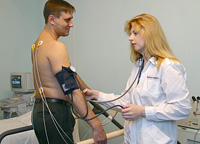 When examining the patient pay attention to the pallor and humidity of the skin
When examining the patient pay attention to the pallor and humidity of the skin
Pokrov, dry, possibly cased, tongue, tachycardia, hypotension - a sign of Grozny
Complications - bacteriotoxic shock. When palpation affected kidney most often
Increased in size, painful. For purulent pyelonephritis forms, the appearance
protective tension of the muscles of the front abdominal wall and the loin on the side of the lesion when
Palpation kidney. Bimanual symptom of acute pyelonephritis and a symptom of Pasternatsky
Positive on the side of the defeat. Laboratory is marked Leukocytosis, as a rule, with
leukocyte formula shift to the left, acceleration of soe. For purulent forms of illness possible
Anemia, Disproteinmia, Improving Urea and Creatinine Serum Creatinine. For
acute pyelonephritis characteristic total pyuria. It is usually a false
Proteinuria. Urine studies in patient pyelonephritis should include definition
bacteriuria and its degrees, bacteriological research with sensitivity determination
Microorganisms for antibacterial drugs.
Of the additional diagnostic methods, first of all should
Executive ultrasound kidneys. Accurate detection of destructive forms of pyelonephritis is possible when
CT help (computed tomography) or MRI (magnetic resonance tomography). Restriction of mobility of the affected kidney when ultrasound is
An additional diagnostic criterion of acute pyelonephritis.
If the ultrasound kidneys cannot be performed for any reason, then
Differential diagnosis of primary and secondary pyelonephritis are carried out on the basis
chromocystoscopy and / or excretory urography. With an excretory urography execution
snapshots on the breath and exhale on one x-ray film just like ultrasound,
Estimate the mobility of the kidneys. Lack or restriction of respiratory excursion affected
The kidneys is a symptom of acute pyelonephritis.
The most modern diagnostic method is MSKT (Multilayer spiral computed tomography),
allowing to establish the cause and the level of possible obstruction of the ureter, as well as
Remove the zones of disturbed blood circulation or foci of purulent destruction in Parenchim
Affected kidney.
Differential diagnosis of acute pyelonephritis should be carried out with
Infectious diseases, acute diseases of the abdominal organs and genitals
(Appendicitis, cholecystitis, adnexit and etc.).
Treatment of pyelonephritis
Patients with acute pyelonephritis need hospitalization. Approach to
treatment of primary and secondary pyelonephritis different.
When identifying secondary (obstructive) pyelonephritis
The first and urgent event is to restore the outflow of urine from the affected bud.
If no more than 2 days have passed since the beginning of the disease and there are no manifestations of purulent-destructive
changes in the affected kidney, recovery of urine outflow is possible by catheterization
Lohanks (conventional ureter catheter or catheter-stent). If it is impossible
The ureteral catheter above the obstruction site shows the punkey percutaneous
nephrostomy.
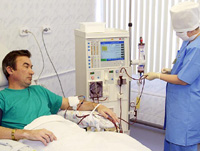 In the primary pyelonephritis and after the recovery of the outflow of urine
In the primary pyelonephritis and after the recovery of the outflow of urine
From the affected kidney during secondary pyelonephritis, pathogenetic is immediately appointed
Treatment based on antibacterial therapy. Antibacterial drugs
There must be a wide range of action with the mandatory influence on the gram-negative flora
(Cephalosporins, fluoroquinolones, aminoglycosides). When identifying the pathogen as a result
Bacteriological studies of urine Antibacterial drugs are chosen taking into account
Antibioticogram. Injected drugs must parenterally in the maximum allowable
Therapeutic dose. In addition, nonsteroidal anti-inflammatory are prescribed
Preparations, preparations that improve blood circulation, complex of intoxication therapy.
No effect from wired therapy for 1-1.5 days or deterioration
the patient testifies to the progressive purulent-destructive process in the kidney, which
is an indication for open operational intervention.
If there is a long history of the disease (more than 3 days) and there
manifestations of purulent-destructive pyelonephritis (pronounced intoxication, dehydration,
Multiple oznoby significant tachycardia, hypotension, protective voltage of the loaf
and the front abdominal wall on the side of the lesion, destructive foci according to computer tomography), then
Open operational intervention is the method of choice.
The purpose of the operation is to stop the purulent inflammatory process, create
conditions for its liquidation, as well as prevent its possible complications by
Improvement of blood and lymph circulation in the affected organ. For this execute decapsulation
kidney, which allows to reduce intravenous pressure, reduce the essay of interstitial
Fabrics and thereby expand the clearance of blood and lymphatic vessels. Operation
Completed nephrostomy. In case of detection during the operation of carbunculov or
abscesses produce their dissection. When involving a purulent destructive process
significant part of the renal parenchyma (2/3 or more) and the impossibility of organ-powder
Operations are performed by nephrectomy.
After completion of the operational intervention is assigned
Antibacterial, anti-inflammatory, disintellation therapy.
Complications of pyelonephritis
From complications of acute pyelonephritis, the development of acute
Pyelonephritis in the opposite kidney, bacteriotoxic shock and sepsis.
Prerequisites for the development of pyelonephritis in the opposite kidney are
Possible disorders of uro- and hemodynamics in it, as well as bacteremia.
Bacteriotoxic shock - The most terrible complication
acute, most often obstructive, pyelonephritis. Mortality from bacteriotoxic shock
ranges from 45 to 55%. It should be paid special attention to the fact that 95% of cases
bacteriotoxic shock have a heroic character. Its occurrence and development of the bowl
all related to the appointment of antibacterial drugs during obstructive pyelonephritis
without restoring the outflow of urine from the affected kidney. This occurs massive death
microorganisms in urinary ways with the formation of a large number of endotoxins that
can not be evacuated with urine due to the obstruction of the ureter. High blood pressure
In a cup-making system, a violation of its integrity against the background of inflammatory changes
contribute to the emergence of a fortnought gyukanko-kidney reflux with penetration
The contents of the cup-making system in the bloodstream.
Therapy of the developed bacteriotoxic shock is
fill in protein deficiency by massive intravenous infusion fresh frozen
plasma, albumin, ripo-liglucine and crystalloid solutions (disol, trisol,
Ringer-Locke and DR.), compulsory administration of glucocorticoids. Considering developing
Endogenous heparin deficiency as a natural humoral neutralizer
Microbial endotoxin It is advisable to replenish it by shock intravenous
Introduction 10 thousand. Heparin ... its further introduction under the skin of the belly of 1250 units every
6 ch.
On the background of acute pyelonephritis and massive bacteremia, even if not
Bacteriotoxic shock develops, the danger of the septic state is extremely large,
Development of severe interstitial pneumonia, hepatitis, meningitis and lesions of others
organs.
Pyelonephritis forecast
With acute pyelonephritis in the stage of serous inflammation, the forecast
favorable if antibacterial therapy started on time (with secondary pyelonephritis
timely restored the outflow of urine from the affected kidney) and the treatment led to a rack
Remissions of the disease. With purulent pyelonephritis forms, the forecast is unfavorable due to
possible complications that can lead to death, as well as due to high
the probabilities of the development of chronic pyelonephritis, often leading to wrinkling kidney and
The emergence of nephrodic arterial hypertension.
Pyelonephritis Prevention is the sanitation of chronic foci
Inflammation in the body.


